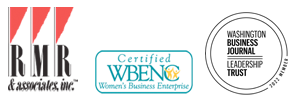Ad Agency dc – Get our free whitepaper!
 This Ad Agency in dc was founded in 1987 and has been run successfully by Robyn Sachs as President since then. In that period it has helped roll out over 350 companies and products, giving RMR a breadth of experience that few other companies have. Its hundreds of clients have made millions of dollars with RMR’s advice and assistance. RMR’s proven processes and practices has great appeal in the high-tech, construction and logistics fields, where an analytic approach and planned execution are highly prized.
This Ad Agency in dc was founded in 1987 and has been run successfully by Robyn Sachs as President since then. In that period it has helped roll out over 350 companies and products, giving RMR a breadth of experience that few other companies have. Its hundreds of clients have made millions of dollars with RMR’s advice and assistance. RMR’s proven processes and practices has great appeal in the high-tech, construction and logistics fields, where an analytic approach and planned execution are highly prized.
As the foremost ad agency in dc dealing with Business to Business (B-to-B) and Business to Government (B-to-G) clients, these clients trust RMR because RMR delivers the promise of the proposal. Our processes and procedures guarantee that you get the progress reporting you need to give you comfort and confidence that your project will be a success. Because RMR will execute the necessary tasks relentlessly to deliver the results that are the promise of your proposal, you get the certainty that what you ask us to do will be done.
Our ad agency in dc is also your one stop shop for other marketing vehicles that leverage your investment in your advertising program and give you the synergy that makes your integrated marketing program more than the sum of its parts.
- Public Relations
- Press releases
- Authored articles
- Feature articles
- Award Opportunities
- Speaking Opportunities
- Web Marketing
- Lead-Generating web sites
- Email marketing campaigns
- Search engine optimization (organic)
- Search engine marketing (AdWords)
- Trade shows
- Positioning and Branding
- Product launches
Says RMR President Robyn Sachs: Let me explain a little more about the way this advertising agency works when it comes to advertising creative and why you should go with RMR.
The pathway to achieving your marketing goals starts with answering the following three questions:
- Who is my target market? By defining who your buyers are, you’ll be able to select the most appropriate media vehicle (print, television, radio, Internet, etc.) to reach them. The media vehicle determines the shape of the creative message.
- What is it they want?Research your prospective market as thoroughly as your budget allows. In many cases, you can negotiate free, or reduced-cost studies of your market from the media vehicle you pay to broadcast your advertising. Customers don’t buy what they need. They buy what they want.
- Why should they buy it from me?The reasons you list here will form the backbone of the creative that drives home your message. Your ad creative must quickly communicate perceptible points of difference. Seemingly small points of differentiation can become the key selling points that lead to success.
Once you’ve answered the above questions, it’s time to build creative that succinctly and uniquely conveys your message and gives the viewer a call to action. Great creative and copy must be driven by a defined purpose. It must communicate to the correct target audience. To be effective, great creative also needs to identify and demonstrate key benefits, stop the reader by communicating a unique personality or tone, and finally, what is so important for increasing profits, leave the potential customer with a call to action. Here are some tips on building great creative:
Headlines. Make them concise, clever and direct. When you think you have them just right, continue to test them. A simple change in a headline has been shown to give 10%, 100% and as much as 1,000% more response.
Benefit-oriented copy. When writing the ad copy, think fact, feature, benefit. Back to another Certs example, the breath mint ad had this voice over: “Certs with Retsyn…” (Fact) “Gives you fresh breath…” (Feature) and the actors conveyed through their actions: “Which makes all the girls go after you…” (Benefit).
Communicate a personality or tone. People don’t buy what they need, they buy what they want. It’s an emotional buying decision, and people sometimes don’t even want to admit that to themselves. Create a personality or tone that first stops the readers to view the ad, then plays to their emotional wants and needs.
Size or frequency? To look big and “safe” to the consumer, choose the largest ad you can afford. But if you must choose between size and frequency, pick frequency. The “rule of seven” says that consumers need seven impressions over a 12-month period to receive your message. Great creative can grab attention even with smaller ads by using color, shape, artwork and headline.
Provide a strong offer. Make your offer very clear. If you can get your offer into the headline, great. If not, make sure you don’t bury it. Types of offers that drive response include discounts, free information, free samples and free product trials.
Leave potential customers with a call to action. Leave your message ringing in the potential customers’ ears. Tell them exactly what you want them to do: Test the product. Call for information. Buy today. Visit your Web site.
An example of great creative that drove sales was a campaign RMR & Associates did for Yurie Systems. Yurie Systems was Business Week’s #1 Hot Growth Company in 1997, and RMR needed to put together a campaign that helped them increase their brand awareness and generate sales leads. We needed to design a campaign that worked as a stop sign in terms of the color, imagery and layout. It needed to stop people and make them pay attention.
Yurie’s product was a computer network protocol product called Intelligent Access Control that through a series of multi-service switches can direct any traffic to any network. The key product attributes were power and grace. Because Yurie’s competitors were all heralding just the bandwidth (power) aspects of their product, RMR’s creative had to herald the importance of both power and grace.
The ad pictured a Sumo wrestler dressed in a tutu with the caption: “More bandwidth won’t always improve performance.” It also told customers to visit Yurie’s Web site to order a free sample CD ROM. Over 1,000 people did just that within the first 30 days of the campaign.
Since then, Yurie was bought by Lucent for a billion dollars. While RMR certainly can’t take all of the credit, having strong products, strong markets, and a strong focus on marketing communications played a significant role in Yurie Systems’ success.
